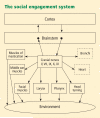The polyvagal theory: new insights into adaptive reactions of the autonomic nervous system
- PMID: 19376991
- PMCID: PMC3108032
- DOI: 10.3949/ccjm.76.s2.17
The polyvagal theory: new insights into adaptive reactions of the autonomic nervous system
Abstract
The polyvagal theory describes an autonomic nervous system that is influenced by the central nervous system, sensitive to afferent influences, characterized by an adaptive reactivity dependent on the phylogeny of the neural circuits, and interactive with source nuclei in the brainstem regulating the striated muscles of the face and head. The theory is dependent on accumulated knowledge describing the phylogenetic transitions in the vertebrate autonomic nervous system. Its specific focus is on the phylogenetic shift between reptiles and mammals that resulted in specific changes to the vagal pathways regulating the heart. As the source nuclei of the primary vagal efferent pathways regulating the heart shifted from the dorsal motor nucleus of the vagus in reptiles to the nucleus ambiguus in mammals, a face-heart connection evolved with emergent properties of a social engagement system that would enable social interactions to regulate visceral state.
Figures

References
-
- Darwin C. The Expression of Emotions in Man and Animals. D Appleton; New York, NY: 1872.
-
- Langley JN. The Autonomic Nervous System. Heffer & Sons; Cambridge, England: 1921.
-
- Hess WR. Diencephalon, Autonomic and Extrapyramidal Functions. Grune & Stratton; New York, NY: 1954.
-
- Porges SW. Vagal tone: a physiologic marker of stress vulnerability. Pediatrics. 1992;90:498–504. - PubMed
-
- Hering HE. A functional test of heart vagi in man. Menschen Munchen Medizinische Wochenschrift. 1910;57:1931–1933.
Publication types
MeSH terms
Grants and funding
LinkOut - more resources
Full Text Sources
Other Literature Sources
Research Materials
